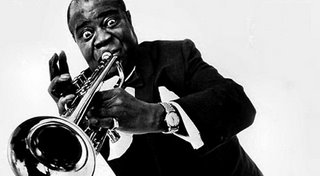Satchmo

"Virtually every jazz musician able to hold his instrument properly has at one time or another been described as a genius; patently, the description is usually unwarranted. But if the term means anything at all, it describes Armstrong." -- J.L. Collier.
The grandson of slaves, Louis Armstrong -- born on this day (not July 4) in 1901 in New Orleans --grew up in the squalor of New Orleans' Storyville section, in which prostitution, booze and violence -- as well as ragtime, "hot" music and brass band marches -- were plentiful. On New Year's Day, 1913, Armstrong was arrested for shooting a pistol in the air and sent to the Colored Waifs' Home. There, at the age of 13, he began to play the cornet for the school band without knowing how to read music, sounding out the alto harmonies by ear -- he later learned to read music while working on Mississippi showboats.
Within four years he was playing cornet in the Kid Ory band (replacing the acclaimed King Oliver, who moved to Chicago), then considered to be one of the best jazz bands in New Orleans. Oliver invited Armstrong to accompany him in Chicago in 1922, and he immediately established himself as the most accomplished and inventive jazz cornetist in the city. In 1924, Armstrong married Oliver's pianist, Lil Hardin (his second of three marriages), who convinced him to leave Oliver's band for the Fletcher Henderson orchestra.
After a year, Armstrong switched to the trumpet (considered to be solely a classical instrument at the time), formed a band with Lil as leader and marched into Okeh Studios to begin recording the sides which became landmarks in the history of jazz, known as Armstrong's "Hot Fives" and "Hot Sevens" recordings. With a warm, full tone, clean attack and astonishing control of the high register of the trumpet, Armstrong's playing was immediately recognizable, his melodies conversational yet enclosed within a meticulously composed structure. He was also one of the earliest jazz musicians (both as trumpeter and vocalist) to take drastic liberties with the time signatures of his pieces, not only extending his phrases and depositing the melody in odd gaps between the beats as others had done before him, but setting whole phrases of melody in a time signature comfortably and richly irrelevant to the beat.
Armstrong toured tirelessly beginning in the 1930s, and for a time continued to make cutting-edge jazz records. By the 1950s, Armstrong was a popular star of stage, screen and radio, appearing in such films as Cabin in the Sky (1943; with Ethel Waters), High Society (1956; with Bing Crosby and Frank Sinatra) and Hello Dolly! (1969; with Barbra Streisand). While his new audience loved his clowning and googly-eyed mugging as he sang pop songs, his early fans were saddened to find him shamelessly appealing to white markets and abandoning his jazz mastery. While Armstrong's oft-played, sentimental vocal rendition of "Wonderful World" (1958) has become something of an American classic, Armstrong the revolutionary musician can still be found in early trumpet triumphs such as "Hotter than Hot" (1927), "Potato Head Blues" (1927) and "Stardust" (1931). Perhaps the most profound legacy he left to jazz was on the outline of the art form itself: after Armstrong, jazz would also be a soloist's saga, not a tale of heroic groups. Armstrong died on July 6, 1971 in New York City.
Labels: Classic Cinema, Jazz





0 Comments:
Post a Comment
Subscribe to Post Comments [Atom]
<< Home